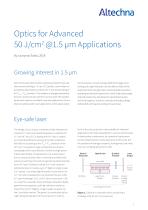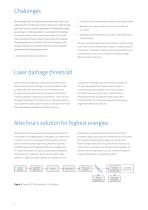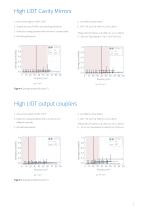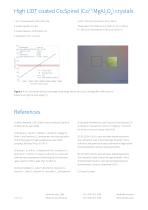
Catalog excerpts

Optics for Advanced 50 J/cm2 @1.5 µm Applications By Laurynas Šatas, 2018 Growing interest in 1.5 μm Over recent years there has been a growing interest for eye-safe communication, remote sensing (LIDAR technology), wind laser sources emitting at ~1.5 μm [1]. Typically, such emission is sensing and range-finding for civil and defence fields. While provided by lasers based on erbium (Er3+) ions and operating on requirements for new generation industrial grade resonators the ⁴I13/2 → ⁴I15/2 transition. This radiation is strongly absorbed by operating at low pulse frequencies include a high pulse energy the eye’s cornea and lens and thus it cannot reach the sensitive and peak power, they also depend on good beam quality retina which opens a new field for eye-safe applications. Erbium and low divergence, as well as a compact and robust design, lasers are widely used in such applications as free-space optical preferentially with passive cooling of a laser head. Eye-safe laser The design of such a laser is relatively simple. Materials for but it is the only production route suitable for industrial compact Er lasers are phosphate glasses co-doped with applications with high repeatability in volumes of thousands Er and Yb ions [2]. Co-doping with Yb ions is needed finished optical components. As a potential replacement to provide the efficient pumping of the laser material at ceramic based solution is discussed around the world, but the problems of damage resistance, homogeneity and many Yb ions. This spectral range corresponds to emission more are not being solved so far. [3,4] wavelengths of the cost-effective commercial high-power InGaAs laser diodes. The generation of a pulsed output from a compact Erbium laser is normally provided by the passive Q-switching. The well-recognized saturable absorber Optical Gain Q-switch Element Laser Output for an Er3+ laser is based on cobalt (Co2+) ions located in Output beam tetrahedral sites of crystals, e.g. Co2+:MgAl2O₄ single crystal (Co :spinel) . It provides high absorption cross-section for 2+ Co2+ ions and, consequently, low saturation fluence at the Er3+ laser wavelength (~0.5 J/cm²), fast recovery time (~350 Laser Pump Diodes Passive Q-switch ns), small non-saturable losses and high modulation depth, good thermal properties, and high radiation resistance. State of the art Co2+:MgAl2O4 single crystals are grown by Output Coupler (partial mirror) the Czochralski method. The growth is complicated by the Figure 1. Typical 8 mJ resonator which could bring a high melting temperature of this compound (~2130 °C),
Open the catalog to page 1
Challenges From first sight, the 8 mJ single shoot (eye-safe limit for class 1 laser safety) doesn’t sound like a big number in the century of high average power laser sources. However, optimization of compact and reliable cavity design is a challenging task for a laser engineer. For example, the resonator which emits 8 mJ with pulse duration at 15 ns and a beam diameter of 100 µm will put components to the challenge of handling more than 5.2 GW/cm² (>38 J/cm²) intracavity, which is hardly achievable in the market. This problem can be solved by optimization of the following parameters: 2....
Open the catalog to page 2
High LIDT Cavity Mirrors 1. Any common glass: N-BK7, UVFS 2. Superb accuracy for ROC and centering tolerances 3. Dielectric coating sputtered with minimum 3 metal oxides 4. EM field optimization *Measured LIDT 100-on-1 @ 1540 nm, 4.1 ns, 100 Hz, 0ᵒ – 39J/cm² (equivalent of > 86.1 J/cm² @ 20 ns) (a) 1-on-1 Figure 4. Damage probability plots. [7] High LIDT output couplers 1. Any common glass: N-BK7, UVFS 2. Dielectric coating sputtered with a minimum of 3 *Measured LIDT 100-on-1 @ 1540 nm, 4.2 ns, 100 Hz, 0ᵒ – 21.3 J/cm² (equivalent of >46.48 J/cm² @ 20 ns) (a) 1-on-1 Figure 5. Damage...
Open the catalog to page 3
High LIDT coated Co:Spinel (Co2+:MgAl2O4) crystals 1. Co2+ Concentrations: (0.05~0.35) wt% 0ᵒ – 38.9 J/cm² (equivalent of >78.6 J/cm² @ 20 ns) 4. Parallelism error: <5 arcsec Figure 3. R-on-1 test results and typical damage morphology: fluence 38.9 J/cm², damage after 1000 pulse(s) in fluence level. High contrast image. [7] References [1] AANSI Standard Z136.1-2000, American National Standard of Saturable Absorbers for Laser Passive Q-Switching near 1.5 lm Based on Transparent Ceramic Co2+:MgAl2O4“ Journal of the American Ceramic Society • April 2016 [2] Karlsson G., Laurell F., Tellefsen...
Open the catalog to page 4






